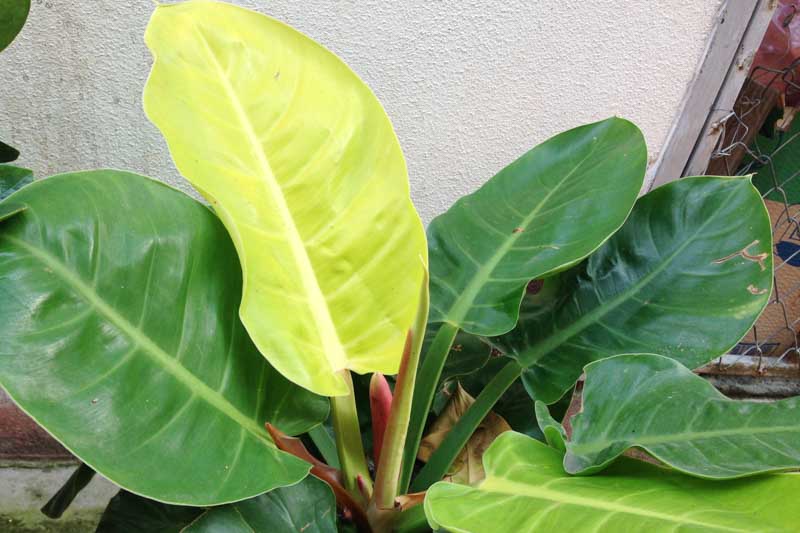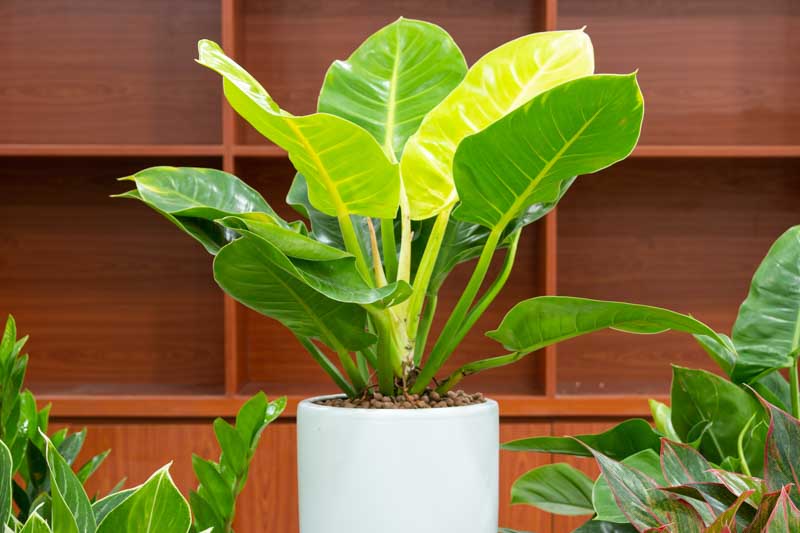Moonlight Philodendron
Philodendron ‘Moonlight’ is a vibrant and distinctive hybrid philodendron that has captured the hearts of plant enthusiasts for its unique foliage and growth habit. This plant stands out in the vast Philodendron family for its fluorescent green leaves, making it a popular choice for indoor gardens.
Philodendron ‘Moonlight’ boasts bright, lime-green leaves that emerge in a striking fluorescent shade, gradually maturing to a softer green while maintaining their luminosity. Unlike many philodendrons with darker foliage, ‘Moonlight’ adds a splash of bright color to any space. Its leaves are large, elongated, and slightly curved, providing a visual texture that is both soft and inviting.
Native: While the ‘Moonlight’ is a cultivated variety, philodendrons, in general, originate from the tropical rainforests of Central and South America. They belong to the arum family (Araceae), along with Zantedeschia (Calla Lily), Caladium (Angel Wing), Monstera (Swiss Cheese Plant), or Colocasia (Elephant Ear).
Plant Type and Habit: Philodendron ‘Moonlight’ is a self-heading variety, meaning it grows upright and does not vine or climb in the same manner as some other philodendrons. The growth habit of this evergreen perennial makes it particularly suitable for indoor settings where space may be at a premium, allowing it to be easily incorporated into a variety of decorative schemes.
Size: This cultivar remains relatively compact, typically reaching about 3-4 feet in height (90-120 cm) and 2 feet in spread (60 cm).
Flowers: While Philodendron ‘Moonlight’ can produce flowers, they are not its primary attraction and are rarely seen in indoor cultivation. The plant is primarily valued and grown for its stunning foliage.
Foliage: The foliage of Philodendron ‘Moonlight’ is undoubtedly its most appealing feature. The bright green leaves not only illuminate any room but also create a lively contrast with darker, more traditional houseplants. The plant’s ability to retain its vibrant color in various lighting conditions adds to its appeal.
Hardiness: It is hardy in USDA zones 10 to 11 and prefers temperatures between 65°F (18°C) and 85°F (29°C). It requires protection from cold drafts and temperatures below 60°F (15°C).
Uses: Its ease of care, coupled with its stunning appearance, makes it a popular choice for enhancing indoor spaces, whether in homes, offices, or commercial settings.
Toxicity: Philodendrons are toxic to humans, cats, and dogs if ingested. They contain calcium oxalate crystals that can cause mouth and stomach irritation. Contact with the sap may cause skin irritation.
Benefits: Beyond its decorative value, it also serves as an air purifier, improving indoor air quality by filtering out certain toxins.

Light: Prefers bright, indirect light. Too much direct sunlight can fade the vibrant leaf colors, while insufficient light can lead to leggy growth. A spot near a window with a sheer curtain is ideal.
Soil: Thrives in well-draining, rich, organic soil. A mix of peat moss, perlite, and vermiculite provides the perfect balance for moisture retention and drainage.
Water: Water when the top inch of soil feels dry. Moonlight Philodendron enjoys consistent moisture but is prone to root rot in overly wet conditions. Ensure the pot has good drainage.
Temperature and Humidity: Prefers warm temperatures between 65°F (18°C) and 85°F (29°C). Protect it from cold drafts and sudden temperature drops to avoid stress. Prefers higher humidity levels, around 60-80%. Use a humidifier, mist the plant regularly, or place it on a pebble tray with water to increase ambient humidity, mimicking its tropical habitat.
Fertilization: Fertilize every 4-6 weeks during the growing season (spring and summer) with a balanced, liquid fertilizer diluted to half the recommended strength. Reduce fertilization in fall and winter.
Pruning: Prune any yellow or damaged leaves to encourage healthy growth. Pruning can also help maintain the plant’s shape and promote fuller growth.
Repotting: Repot every 2-3 years or when the plant becomes root-bound. Choose a pot only slightly larger than the previous one to prevent excess soil moisture.
Propagating Philodendron plants is a straightforward and rewarding process, allowing you to expand your collection or share with friends and family. The most common method is stem cuttings, which can be rooted in water or soil. Here’s how to do it:

Philodendrons can encounter pests, diseases, and other common problems, especially when grown indoors.
Spider Mites: These tiny pests can be identified by the fine webs they weave on the plant. They cause yellowing or speckled leaves. Increase humidity around the plant and wash it with a strong stream of water. For severe infestations, use insecticidal soap or neem oil.
Mealybugs: These white, cottony pests tend to cluster in leaf axils and under leaves, sucking sap and weakening the plant. Remove with alcohol-dipped cotton swabs or apply neem oil.
Aphids: Small, soft-bodied insects that can be green, black, brown, or pink, aphids typically feed in groups on the undersides of leaves. Combat them with a gentle spray of water, neem oil, or insecticidal soap to protect the plant’s health and appearance.
Scale insects: Hard or soft-bodied insects that attach themselves to the stems or leaves, causing yellowing and growth stunting. Scrape off with a fingernail or use a cotton swab dipped in rubbing alcohol. Insecticidal soap or neem oil may also be used.
Root rot: Overwatering is the primary cause, leading to brown, mushy roots and yellowing leaves. Reduce watering, improve drainage, and repot the plant into fresh, well-draining soil. Severely affected roots should be trimmed before repotting.
Leaf spot: Fungal or bacterial infections can cause dark or black spots on leaves, often with a yellow halo. Increase air circulation, avoid wetting leaves when watering, and remove affected leaves. Fungicides or bactericides may be necessary in severe cases.
Yellowing Leaves: Often a sign of overwatering or poor drainage. Ensure the plant is in well-draining soil and adjust your watering schedule to allow the soil to dry slightly between waterings.
Brown Leaf Tips: Can indicate low humidity, especially in dry indoor environments. Increase humidity around the plant with a humidifier, pebble tray, or by misting the leaves regularly.
Leaf Scorch: Direct sunlight can cause the leaves to scorch, leading to brown patches or fading of the vibrant leaf colors. Position the plant in a location where it receives bright, indirect light.
Drooping Leaves: This can be a sign of both underwatering and overwatering. Check the soil moisture to determine the cause and adjust your watering accordingly.
Slow Growth or Lack of Color: Insufficient light can lead to less vibrant leaf coloration and slow growth. Ensure your philodendron is receiving enough indirect light to maintain its rich hues and promote healthy growth.
| Hardiness |
10 - 11 |
|---|---|
| Plant Type | Houseplants, Perennials |
| Plant Family | Araceae |
| Genus | Philodendron |
| Exposure | Partial Sun |
| Season of Interest |
Spring (Early, Mid, Late) Summer (Early, Mid, Late) Fall Winter |
| Height |
3' - 4' (90cm - 120cm) |
| Spread |
1' - 2' (30cm - 60cm) |
| Maintenance | Low |
| Water Needs | Average |
| Soil Type | Loam |
| Soil pH | Acid, Neutral, Alkaline |
| Soil Drainage | Moist but Well-Drained |
| Characteristics | Showy, Evergreen |
| Tolerance | Deer, Rabbit |
| Garden Uses | Patio And Containers |
| Hardiness |
10 - 11 |
|---|---|
| Plant Type | Houseplants, Perennials |
| Plant Family | Araceae |
| Genus | Philodendron |
| Exposure | Partial Sun |
| Season of Interest |
Spring (Early, Mid, Late) Summer (Early, Mid, Late) Fall Winter |
| Height |
3' - 4' (90cm - 120cm) |
| Spread |
1' - 2' (30cm - 60cm) |
| Maintenance | Low |
| Water Needs | Average |
| Soil Type | Loam |
| Soil pH | Acid, Neutral, Alkaline |
| Soil Drainage | Moist but Well-Drained |
| Characteristics | Showy, Evergreen |
| Tolerance | Deer, Rabbit |
| Garden Uses | Patio And Containers |
How many Philodendron ‘Moonlight’ do I need for my garden?
| Plant | Quantity | |
|---|---|---|
| Philodendron ‘Moonlight’ | N/A | Buy Plants |
Create a membership account to save your garden designs and to view them on any device.
Becoming a contributing member of Gardenia is easy and can be done in just a few minutes. If you provide us with your name, email address and the payment of a modest $25 annual membership fee, you will become a full member, enabling you to design and save up to 25 of your garden design ideas.
Join now and start creating your dream garden!
Create a membership account to save your garden designs and to view them on any device.
Becoming a contributing member of Gardenia is easy and can be done in just a few minutes. If you provide us with your name, email address and the payment of a modest $25 annual membership fee, you will become a full member, enabling you to design and save up to 25 of your garden design ideas.
Join now and start creating your dream garden!